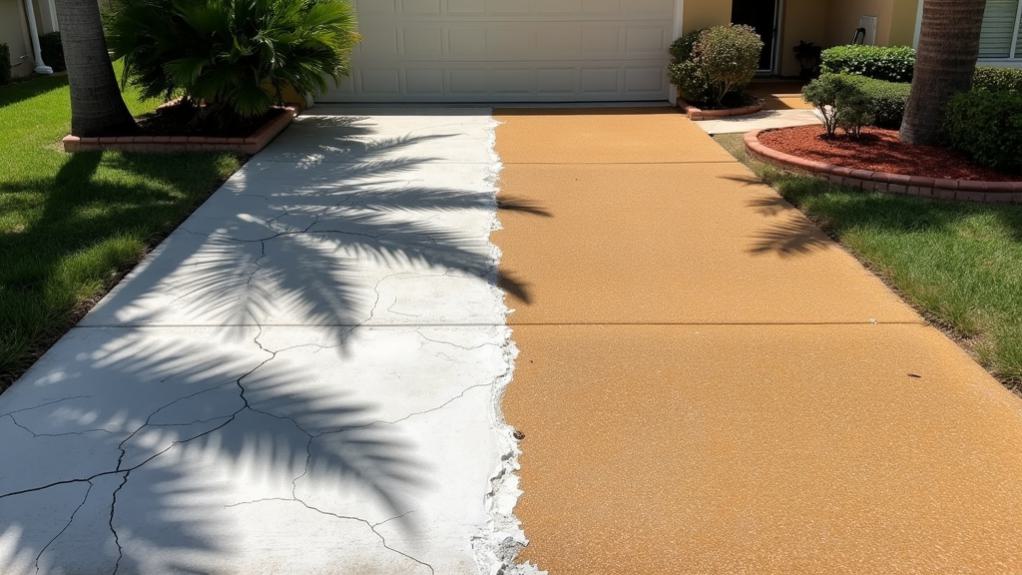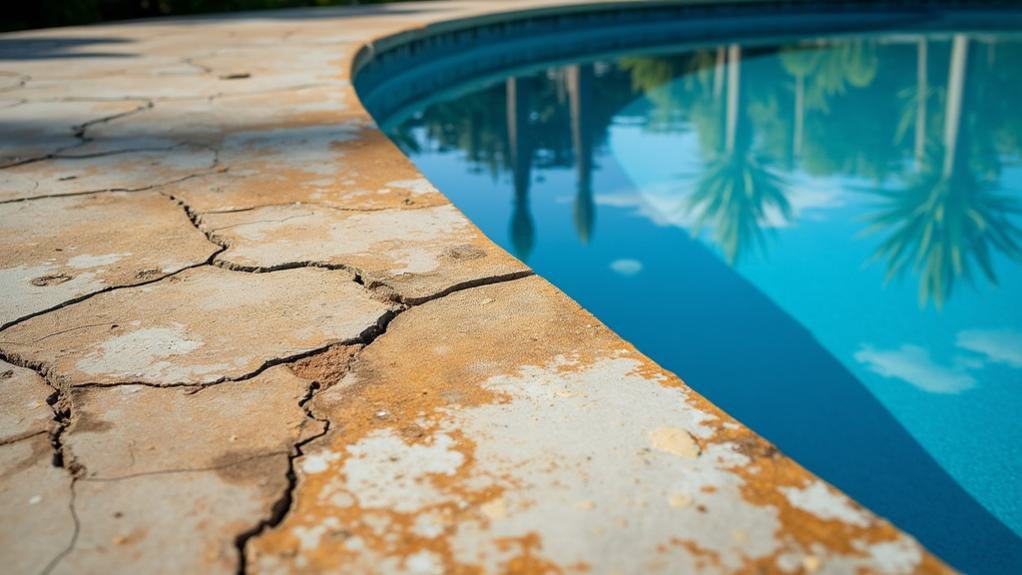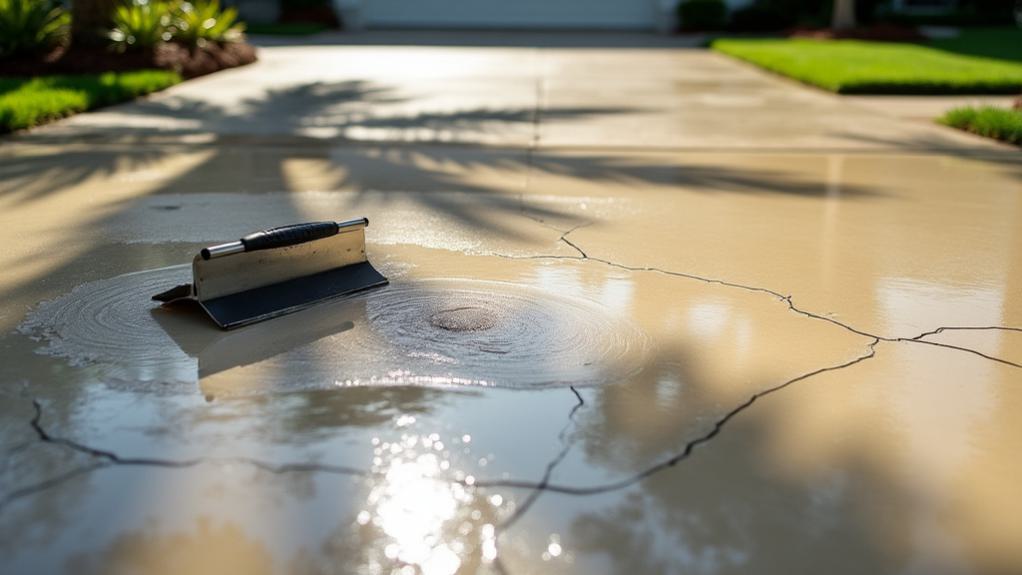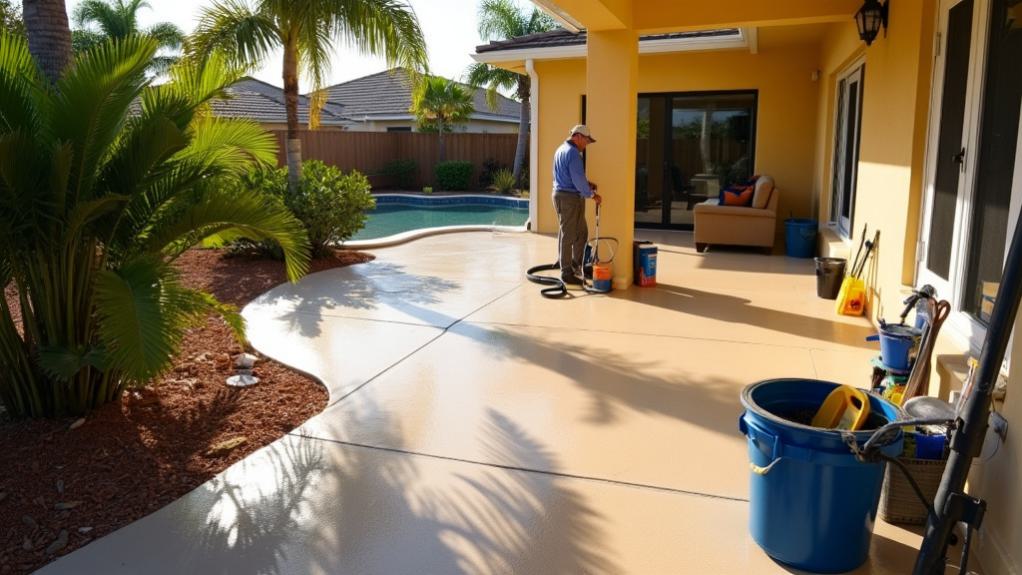Concrete resurfacing is a cost-effective method to revitalize worn or damaged surfaces in Florida properties. This process involves applying a thin layer of cement-based material over existing concrete, offering aesthetic enhancement and weather resistance. Common applications include driveways, pool decks, patios, and walkways. The resurfacing process typically involves cleaning, repairing, and applying a bonding agent before the new surface is added. Various materials and techniques, such as polymer-modified overlays and decorative stamping, can be employed. Costs vary based on area size, condition, and desired finish. Proper maintenance ensures longevity in Florida's subtropical climate. Selecting an experienced contractor is crucial for optimal results.
Understanding Concrete Resurfacing

Delving into the realm of concrete restoration, concrete resurfacing offers a cost-effective solution for revitalizing worn or damaged surfaces. This process involves applying a thin layer of cement-based material over existing concrete, effectively renewing its appearance and functionality. Resurfacing techniques vary depending on the condition of the original surface and the desired outcome.
Common resurfacing methods include spray-on overlays, stamped overlays, and self-leveling compounds. Each technique addresses specific issues and can be tailored to different concrete types, such as driveways, patios, or pool decks.
Spray-on overlays are ideal for adding texture and slip resistance, while stamped overlays can mimic the appearance of more expensive materials like brick or stone. Self-leveling compounds are particularly effective for smoothing uneven surfaces.
Before undertaking a resurfacing project, it's crucial to assess the underlying concrete's condition. Severe structural damage or extensive cracking may require more intensive repair methods.
Additionally, proper surface preparation, including cleaning and repairing minor imperfections, is essential for ensuring the new overlay adheres properly and achieves a durable finish.
Benefits for Florida Properties
Concrete resurfacing offers significant advantages for Florida properties, particularly in terms of aesthetic enhancement and structural resilience.
By improving curb appeal, resurfaced concrete surfaces can substantially increase a property's market value.
Additionally, the weather-resistant qualities of properly resurfaced concrete are especially beneficial in Florida's climate, protecting against moisture intrusion and UV damage.
Improved Curb Appeal
One of the primary benefits of concrete resurfacing for Florida properties is the significant improvement in curb appeal. This aesthetic transformation can dramatically enhance the overall appearance of a home or commercial building, increasing its neighborhood appeal and potentially its market value.
Concrete resurfacing offers a cost-effective solution to revitalize worn, stained, or damaged concrete surfaces. The process involves applying a thin layer of specially formulated concrete overlay material, which can be customized with various colors, patterns, and textures.
This versatility allows property owners to achieve a fresh, modern look that complements the architectural style of their building and the surrounding landscape.
In Florida's competitive real estate market, enhanced curb appeal can be a decisive factor for potential buyers or tenants. Resurfaced concrete driveways, walkways, patios, and pool decks create a polished, well-maintained appearance that stands out in the neighborhood.
This visual improvement not only attracts attention but also conveys a sense of pride in property ownership and meticulous maintenance, which can positively influence property appraisals and overall desirability in the local market.
Enhanced Property Value
Beyond aesthetic improvements, concrete resurfacing offers tangible financial benefits for Florida property owners. This cost-effective renovation technique can significantly enhance property value, making it an attractive option for those looking to maximize their property investment. Resurfaced concrete surfaces, whether driveways, patios, or pool decks, contribute to increased market appeal, potentially leading to higher resale values.
The financial advantages of concrete resurfacing include:
- Lower maintenance costs compared to frequent repairs or complete replacements
- Extended lifespan of existing concrete structures
- Improved energy efficiency through reflective coatings
Real estate professionals often emphasize the importance of curb appeal in property valuation. Well-maintained, aesthetically pleasing concrete surfaces can create a positive first impression, potentially increasing a property's perceived value. This is particularly relevant in Florida's competitive real estate market, where outdoor living spaces are highly valued.
Moreover, concrete resurfacing can be a strategic move for property owners planning to sell. The relatively low investment in resurfacing can yield a substantial return by enhancing the overall appeal and functionality of outdoor areas, potentially expediting the sale process and commanding higher offers from prospective buyers.
Weather-Resistant Surfaces
Florida's subtropical climate presents unique challenges for outdoor surfaces, making weather resistance a critical factor in concrete resurfacing. The state's high humidity, intense UV exposure, and frequent rainfall can accelerate the deterioration of traditional concrete surfaces.
Resurfaced concrete, however, offers superior climate adaptability and enhanced surface durability. Modern resurfacing materials are engineered to withstand Florida's extreme weather conditions. These specialized coatings form a protective barrier that resists moisture penetration, preventing water damage and reducing the risk of cracks and spalling.
Additionally, UV-resistant formulations help maintain color integrity and prevent fading, ensuring the surface remains aesthetically pleasing for years. The improved weather resistance of resurfaced concrete extends its lifespan, reducing the need for frequent repairs or replacements.
This durability is particularly beneficial for high-traffic areas such as driveways, pool decks, and patios. Moreover, weather-resistant surfaces are less prone to algae and mold growth, a common issue in Florida's humid environment.
This resistance not only maintains the surface's appearance but also contributes to a safer, slip-resistant texture, especially important during Florida's rainy seasons.
Common Applications in Florida

Concrete resurfacing finds widespread use across various outdoor spaces in Florida properties.
Driveways and pool decks are prime candidates for this treatment, enhancing both aesthetics and functionality.
Patios and walkways also benefit significantly from concrete resurfacing, improving their appearance and durability in Florida's challenging climate.
Driveways and Pool Decks
Two of the most common applications for concrete resurfacing in Florida are driveways and pool decks. Driveways benefit significantly from resurfacing, as it enhances their aesthetics and functionality. The process can repair cracks, level uneven surfaces, and add slip-resistant textures, improving both appearance and safety. For driveway aesthetics, homeowners can choose from various colors, patterns, and finishes to complement their property's style.
Pool decks are another prime candidate for resurfacing due to constant exposure to water, chemicals, and UV rays. Resurfacing addresses pool deck safety concerns by:
- Adding slip-resistant surfaces
- Eliminating trip hazards from cracks or uneven areas
- Reducing heat absorption for cooler surfaces
The resurfacing process for both driveways and pool decks typically involves cleaning the existing concrete, repairing damages, and applying a new surface layer. This layer can be customized with decorative elements like stamped patterns or exposed aggregate finishes.
In Florida's climate, contractors often use specialty coatings designed to withstand high humidity, intense sunlight, and occasional freeze-thaw cycles. These coatings provide durability and longevity, making concrete resurfacing a cost-effective solution for rejuvenating outdoor spaces.
Patios and Walkways
While driveways and pool decks are popular choices for concrete resurfacing, patios and walkways also present significant opportunities for improvement in Florida homes. These outdoor living spaces can be transformed through various resurfacing techniques, enhancing both aesthetics and functionality.
For patios, concrete resurfacing allows homeowners to explore a wide range of patio designs, from simple stamped patterns to intricate textures mimicking natural stone or tile. The process can address common issues such as cracks, stains, and uneven surfaces, while also providing UV resistance and improved slip resistance, crucial for Florida's climate.
Walkways benefit similarly from resurfacing, with options for walkway patterns that complement the home's architecture and landscaping. Decorative overlays can create visually appealing paths that withstand heavy foot traffic and resist weathering.
Additionally, resurfacing can incorporate safety features like textured surfaces for better traction during Florida's frequent rain showers.
Both patios and walkways can be customized with color options, sealers, and specialized coatings to enhance durability and reduce maintenance requirements. This makes concrete resurfacing an efficient and cost-effective solution for updating outdoor spaces in Florida homes.
The Resurfacing Process
Executing the concrete resurfacing process requires meticulous preparation and attention to detail. The first step involves thoroughly cleaning the existing surface, removing any dirt, debris, or loose material.
Professionals then repair any cracks or damaged areas to ensure a smooth foundation for the new surface.
Next, contractors apply a bonding agent to promote adhesion between the old concrete and the new overlay. The resurfacing material is then mixed according to manufacturer specifications, considering factors such as temperature and humidity.
Application methods vary depending on the desired finish and may include:
- Spray application for uniform coverage
- Trowel application for textured finishes
- Squeegee application for smooth surfaces
The resurfacing material is applied in thin layers, allowing each layer to dry before proceeding.
Skilled technicians use various resurfacing techniques to achieve the desired aesthetic, such as stamping, staining, or scoring patterns into the fresh overlay.
Materials and Techniques

Concrete resurfacing professionals in Florida utilize a variety of materials and techniques to achieve durable, aesthetically pleasing results. The primary resurfacing materials include polymer-modified cement overlays, epoxy coatings, and acrylic concrete resurfacers. These products are designed to bond strongly with existing concrete surfaces while providing enhanced durability and weather resistance.
Application techniques vary depending on the specific material and desired outcome. For polymer-modified cement overlays, professionals typically employ trowel application or spray-on methods. Epoxy coatings are often applied using rollers or squeegees, while acrylic resurfacers may be sprayed or rolled onto the surface.
Proper surface preparation is crucial for all resurfacing projects, involving thorough cleaning, repair of cracks or damage, and priming as necessary.
Advanced techniques such as stamping, stenciling, or acid staining can be employed to create decorative patterns or textures. These methods allow for customization of the resurfaced concrete, enhancing its aesthetic appeal.
Professionals may also incorporate aggregate materials or color pigments to achieve specific visual effects or improve slip resistance.
Cost Considerations
The cost of concrete resurfacing in Florida varies widely depending on several factors. When budget planning for a resurfacing project, homeowners and contractors must consider the following elements:
- Size of the area to be resurfaced
- Condition of the existing concrete
- Desired finish and aesthetics
Material selection plays a crucial role in determining the overall cost. High-quality polymer-modified overlays typically cost more than basic cement-based options but offer superior durability and aesthetic appeal.
Labor costs also contribute significantly to the total expense, with intricate designs or patterns requiring more time and skill to execute.
On average, basic concrete resurfacing in Florida can range from $3 to $5 per square foot, while more elaborate finishes may cost up to $15 per square foot.
Additional expenses may include surface preparation, repairs to the existing concrete, and sealing.
It's essential to obtain multiple quotes from reputable contractors and carefully review the scope of work to ensure accurate cost comparisons.
Maintenance and Longevity

For optimal performance and extended lifespan, properly maintained concrete resurfacing in Florida requires regular care and attention.
Implementing preventive measures and conducting routine inspections are crucial steps in preserving the integrity and appearance of resurfaced concrete surfaces.
To ensure longevity, homeowners should establish a maintenance schedule that includes regular cleaning, sealing, and inspections.
Cleaning should be performed using non-abrasive methods and pH-neutral cleaners to prevent damage to the surface.
Resealing the concrete every 2-3 years helps protect against moisture intrusion, UV damage, and staining.
Routine inspections allow for early detection of potential issues such as cracks, chips, or signs of wear.
Addressing these problems promptly can prevent more extensive damage and costly repairs.
In Florida's humid climate, it's essential to monitor for mold or mildew growth and address any drainage issues that may affect the concrete's durability.
Choosing a Resurfacing Contractor
When selecting a resurfacing contractor in Florida, homeowners should prioritize experience, expertise, and reputation. Evaluating contractor qualifications is crucial to ensure high-quality workmanship and long-lasting results. Research potential contractors thoroughly, focusing on their track record with concrete resurfacing projects in Florida's unique climate conditions.
Consider the following factors when choosing a resurfacing contractor:
- Licensure and insurance: Verify that the contractor holds valid state licenses and adequate insurance coverage.
- Portfolio and references: Review past projects and contact previous clients to gauge satisfaction levels.
- Technical knowledge: Assess the contractor's understanding of various resurfacing techniques and materials suitable for Florida's environment.
Discuss project timelines with potential contractors, ensuring they can accommodate your schedule while allowing sufficient time for proper preparation and curing.
Request detailed written estimates that outline all aspects of the job, including surface preparation, materials, labor costs, and any potential additional charges.
Compare multiple bids to make an informed decision, but avoid selecting solely based on price. A reputable contractor will provide clear communication, adhere to agreed-upon timelines, and deliver superior results that enhance your concrete surfaces' aesthetics and durability.
Conclusion
Concrete resurfacing offers a cost-effective solution for revitalizing aging concrete surfaces in Florida's challenging climate. This process enhances aesthetics, improves functionality, and extends the lifespan of existing concrete structures. By employing advanced materials and techniques, resurfacing addresses common issues like cracks, spalling, and discoloration. Property owners must consider factors such as cost, maintenance requirements, and contractor expertise when opting for this renovation method. Proper implementation of concrete resurfacing can significantly increase property value and curb appeal while withstanding Florida's unique environmental conditions.
